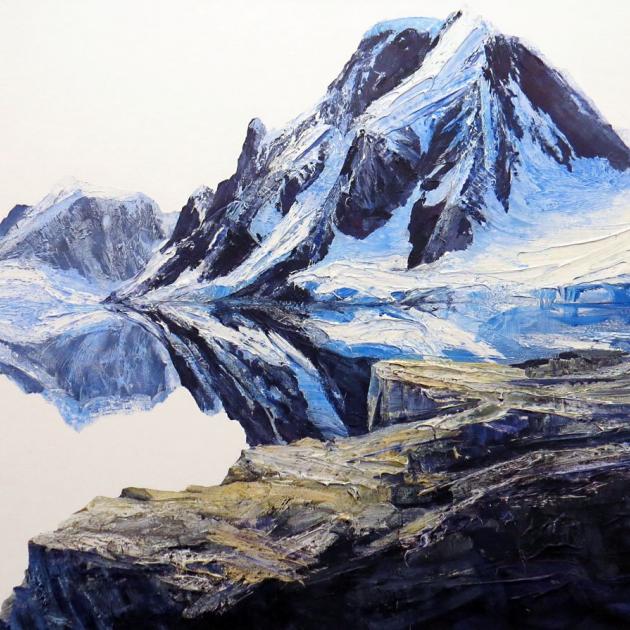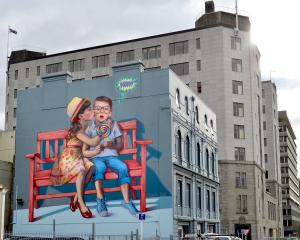
''Escapist'', Neil Frazer (Milford Galleries Dunedin)
This may not be the optimum time of the year to view an exhibition of landscapes of frozen rock and ice, yet Neil Frazer's ''Escapist'' at Milford Galleries is excellent enough to make such a view worthwhile.
In a series of massive panels, Frazer presents the Antarctic as a compelling, tangible presence: vast, uncompromising, and utterly beautiful.
His images make shrewd use of mixed media: skies are presented in empty, flat white acrylic; crags and glaciers are fiercely impastoed oils, applied thickly via brush, knife and direct from the tube.
This deliberate dichotomy only serves to enhance the grandeur of the land.
The bold oils have been worked intensely, dragged and scored across the canvas with a chutzpah which comes with mastery of a medium.
No less extreme is the palette used to represent what we often imagine as a black-and-white world.
The rich ultramarines and earthy browns perfectly convey the emptiness and physicality of The Big Ice, while at the same time giving it an alien presence.
The landscapes presented are composites: reinventions and reinterpretations.
Yet, despite not being real locations, the landforms of White Slide, Cold Point and the massive Ice Age are unrelentingly real and effectively capture the essence of the world's most tantalising yet least known continent.''

New Works'', John Badcock (Gallery De Novo)
Impasto is also the order of the day at Gallery De Novo, where John Badcock presents a series of heavily worked impressionistic pieces, the majority of which are views of Dunedin streetscapes.
Badcock has used the paint in short heavy strokes, giving a sketch-like yet strong sensation of the motion and vivid energy of the city.
In works such as Looking North and Warrender Street, pinpoint representation is completely eschewed, the sense of the city emerging forcefully from the chaos of the brush marks.
This is no mean feat on the part of the artist, who has successfully captured the essence of Dunedin from what seems at first glance to be haphazard paint strokes.
Most impressively, pieces like AM, High Street effectively render the perspective of the scene via perfectly placed slashes of colours.
The same gestural strength can be found in the artist's other pieces.
In Careys Bay and Kale Seed Badcock uses the same techniques to portray the rippling waters of the harbour and a field of crops effectively, the latter in an almost Pollock-like frenzy of colour.
The two portraits presented, Ange I and Ange II are also impressive pieces, though the necessity of their more formal structure perhaps renders them somewhat less effective than the other works in the exhibition.''

Dawn Watch'' and ''A Tent For The Sun'', Wallace Crossman (St. Paul's Cathedral)
A cathedral seems an unusual place for an art exhibition, but there are few sites more suitable for the display of beautiful, loving creation.
Religious buildings are, after all, dedicated to the praise of creation and Creator, and art merely reflects this glory.
Wallace Crossman has, in two series of works, ''Dawn Watch'' and ''A Tent For The Sun'', filled the cathedral's apse with light and colour.
The exhibition's opening work, The Dawning, is a deep, sombre piece, inspired by the poetic opening of St John's Gospel.
In it, the Gospel's words emerge into the light from indigo cloud.
This design finds substance in ''Dawn Watch'', 12 pieces in which the peaceful transition from night to day serves as an allegory of the creation of the universe.
The idea of one great message with 12 messengers has also, of course, strong Christian symbolism.''
A Tent For The Sun''takes its lead from Psalm 19 and the fiery Maniototo sky.
The works culminate in four massive panels where the sheer glory of light is rendered in vivid hues.
The works are overwhelming from the ambulatory path around the apse, but from the back of the nave provide a wonderful warmth to the cathedral that is perfectly in keeping with their surroundings.
Note: Advertising states the exhibition is open until 4pm, but the cathedral closes at 3pm












